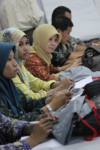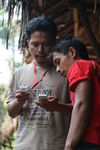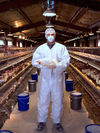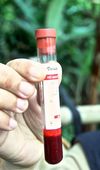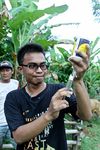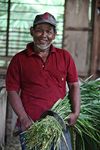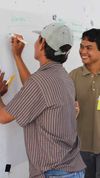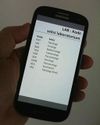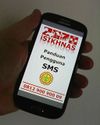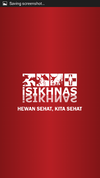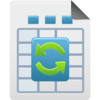ISIKHNAS Training Resources/en: Perbedaan revisi
(Importing a new version from external source) |
(Importing a new version from external source) |
||
| Baris 4: | Baris 4: | ||
[[Image:ISIKHNAS mini logo.svg|80px|left]] | [[Image:ISIKHNAS mini logo.svg|80px|left]] | ||
| + | |||
| + | {| | ||
| + | |- | ||
| + | |'''Modul Inti : Core Modules'''|| [[File:Petugas_dinas.png|70px|link=Routine Disease Reporting and Case Management/id|M1 Laporan routin]] || [[File:Pelsa_icon2.png|70px|link=Pelsa/id|M2 Pelsa]]|| [[File:Sms_queries.svg|80px|link=Queries|M11 Kueri sistem ]]|| [[File:SKKH_Logo.png|70px|link=Health Certificates for Livestock Movement/id|M4 SKKH]] | ||
| + | |- | ||
| + | | || || || | ||
| + | |- | ||
| + | | || [[File:Investigasi.png|70px|link=Priority Disease Investigation|M3 Investigasi Penyakit Prioritas]] ||[[File:Vaccination2.png|70px|link=Vaccination|M7 Vaksinasi]] ||[[File:Active_Surveilans.png|70px|link=Active Surveillance|M5 Surveilans Actif]] || [[File:Population.png|80px|link=Population|M6 Populasi]]|| | ||
| + | |- | ||
| + | | || || || | ||
| + | |- | ||
| + | |'''Hewan identifikasi: Animal ID'''||[[File:ID Hewan.png|70px|link=Farmer Registration and Animal ID|M9 ID Hewan dan Pemilik]] ||[[File:ID plus kasus.png|70px|link=Animal ID and Health Reporting/id|M21 ID Hewan dan Laporan Routin]]|| [[File:Binary-tree256.png|70px|link=Breeding Management|M10 Manajemen Produksi Ternak]] | ||
| + | |- | ||
| + | | || || || | ||
| + | |- | ||
| + | |'''Other tools''' ||[[File:App2.png|70px|link=Mobile App|M19 App Android]] || [[File:Instant_Messaging.jpg|70px|link=Instant Messaging|M8 Instant Messaging]]|| | ||
| + | |- | ||
| + | | || || || | ||
| + | |- | ||
| + | |'''Modul Koordinator : Coordinator Modules'''||[[File:Coordinator.png|120px|link=Coordinators/id|M14 Koordinator]]||[[File:Spatial data 14.png|70px|link=Changing location data/id|M22 Pengelolaan Data Spasial]] || [[File:WIKI_LOGO.png|70px|link=Wiki Work|M15 Wiki]] || [[File:Courses.png|70px|link=Training Management|M17 Manajmen Pelathihan]]|| | ||
| + | |} | ||
==Summary== | ==Summary== | ||
| Baris 109: | Baris 130: | ||
{{fpblock|Module 24 : Involving local human health staff in iSIKHNAS|Red flag.svg| | {{fpblock|Module 24 : Involving local human health staff in iSIKHNAS|Red flag.svg| | ||
Some kabupaten are choosing to involve human health staff in iSIKHNAS where there are suspected zoonotic cases of disease. These personnel or village level health reporters can be sent alerts via SMS so that everyone can be involved in protecting the community. Coming soon, this module will help kabupaten coordinators to register and involve local level human health staff in the system.|Human health}} | Some kabupaten are choosing to involve human health staff in iSIKHNAS where there are suspected zoonotic cases of disease. These personnel or village level health reporters can be sent alerts via SMS so that everyone can be involved in protecting the community. Coming soon, this module will help kabupaten coordinators to register and involve local level human health staff in the system.|Human health}} | ||
| + | |||
| + | {{fpblock|Module 25 : Livestock Insurance|Red flag.svg| | ||
| + | Livestock insurance|Livestock insurance}} | ||
Revisi terkini pada 10 Juli 2017 17.32
Daftar isi
- 1 iSIKHNAS Training Centre
- 2 Summary
- 3 Information for Trainers and Coordinators
- 4 iSIKHNAS Training Modules
- 5 Module 1 : Routine Disease Reporting and Case Management
- 6 Module 2 : Pelsa : Village Reporters
- 7 Module 3 : Priority Disease Investigation and Response
- 8 Module 4 : Health Certificates for Livestock Movement
- 9 Module 5 : Active Surveillance Activities
- 10 Module 6 : Village Population Statistics
- 11 Module 7 : Vaccination Activities
- 12 Module 8 : Using Instant Messaging with iSIKHNAS
- 13 Module 9 : Farmer Registration and Animal Identification
- 14 Module 10 : Breeding Management
- 15 Module 11 : System Queries
- 16 Module 12 : Administration SMS
- 17 Module 13 : Abattoir Reporters
- 18 Module 14 : iSIKHNAS Coordinator
- 19 Module 15 : Contributing to the iSIKHNAS WIKI
- 20 Module 16 : Using the iSIKHNAS data and reports
- 21 Module 17 : Training Management
- 22 Module 18 : Spreadsheet uploads
- 23 Module 19 : iSIKHNAS Mobile App
- 24 Module 20 : Laboratory data exchange
- 25 Module 21 : Reporting for individually identified animals
- 26 Module 22 : Changing administrative boundary data
- 27 Module 23 : Applying for enhancements and new features in iSIKHNAS
- 28 Module 24 : Involving local human health staff in iSIKHNAS
- 29 Module 25 : Livestock Insurance
iSIKHNAS Training Centre
| Modul Inti : Core Modules |  |
 |

| ||
 |
 |
 |
|||
| Hewan identifikasi: Animal ID |  |
 |

| ||
| Other tools |  |
 |
|||
| Modul Koordinator : Coordinator Modules |  |
 |
 |
Summary
This section is designed for trainers and others involved in preparing training for veterinary and animal health staff in Indonesia to assist them in using the National Animal Health Information System, iSIKHNAS.
Training for iSIKHNAS is divided into manageable Training Modules. These modules are designed
- to ensure training is as quick and efficient as possible - most are one day or less,
- to reduce the amount of preparation required by trainers,
- to ensure consistency of materials and approach,
- to be as flexible as possible so that they can be used in response to local needs and priorities,
- to be used for group and individual use, for training and as self-learning units,
- to encourage an ongoing program of staff development.
Information for Trainers and Coordinators
This powerful system comprises a wide variety of functions for a range of different animal health staff so in order to make training more manageable and efficient, these functions have been broken down into short, purpose-specific modules, most of which can be trained in one day and often less.
It is intended that when iSIKHNAS is first introduced into a district ALL veterinary staff involved in day to day animal health services to farmers and their animals be trained by the new district coordinator with assistance from the provincial coordinator and an expert trainer. The first module will always be Module 1 : Routine Disease Reporting and Case Management. This module initiates staff to the important founding principles and philosophy behind iSIKHNAS, introduces the core functionality and reporting mechanisms and allows for more practice and familiarisation with the new service-driven system. This module comprises routine and priority disease reports from the field, treatments, lab submissions, follow up and outcomes - the most common, core tasks undertaken by most staff in district offices. Module 1 is the prerequisite to all other modules intended for this group of technical field staff.
From experience, the first module requires motivated and well-supported trainers with good energy levels, lots of patience and time to allow new users of the system opportunity to practice and gain confidence. It is the module which will determine how well staff adapt to change and embrace the ongoing training of new features in the future. It will set the tone for the other modules which follow. After this first module, district coordinators become solely responsible for developing and undertaking an ongoing training plan for staff. Such a plan should be responsive to the district and provincial priorities, but also to the level of staff motivation and interest and their ability to absorb and adopt new practices. It should be noted that it will be the eventual responsibility of the district coordinator to train all new staff (who are new to iSIKHNAS and new to the district or province) in Module 1 as the need arises. By the time this is necessary there will be many more confident users able to assist in this training task.
Once the basic principles, the first SMS messages and the reflex to use the extensive system queries to help with accurate reporting have been mastered, experience shows that staff pick up and use all subsequent messages very quickly and easily. It is recommended that at least one new module be introduced to staff every month, bearing in mind that not all staff will require the all the tools available so the target audience may differ each time. Not all staff are involved in production and breeding or Abattoir reporting, not all staff will require the Priority Disease Investigation and Response training, and so on. Some modules, such as Village Population Statistics, Vaccination Activities or Active Surveillance (Modules 5, 6 and 7), involve one message each and should come just prior to the planned activities of collecting and recording village animal population data, or a planned vaccination activity as part of a district or provincial program, or a planned sampling activity as part of an active surveillance program.
Some modules are dependent on others and must follow in a logical sequence, Module 9 : Farmer Registration and Animal Identification must precede Module 10 : Breeding Management, for example. Some modules will only be of use and interest to a very small group of system users and so Coordinators may decide to give ad-hoc, one-on-one training in, for example, the use of Instant Messaging (Module 8) or the use of iSIKHNAS data using the website (Module 16). A few modules will be useful to staff with greater administrative responsibility in order to provide the coordinator with greater support in farmer and animal registration, spreadsheet uploads or training management (Module 9, 17 and 18).
For those districts with a network of village-level reporters, Module 2 : Pelsa : Village Reporter module should probably follow quickly after the first module. Staff will be able to assist in the training which often requires higher levels of input and reassurance. A Signs Recognition sub-module can be conducted at the same time to further engage and equip this valuable resource.
As soon as training in a module has taken place, it is imperative that staff commence to use the new tools (sms messages, most often) immediately. It must be adopted by all relevant staff at the same time to ensure excellent compliance from the outset. Coordinators should monitor the system particularly closely during the initial period directly after training has occurred. Staff should never be left to make too many mistakes and become frustrated. Coordinators have monitoring tools at their fingertips which can help to diagnose reporting problems and offer immediate support and advice to staff having difficulties. These should be used to their fullest during this adoption phase.
iSIKHNAS Training Modules
Module 1 : Routine Disease Reporting and Case Management
This is the first and most fundamental of the iSIKHNAS modules. It introduces district level technical staff to the iSIKHNAS system, its philosophy and the key functions of the system. It concentrates on developing skills in the reporting of routine and priority disease events, response reports, treatments, specimen submissions to the lab and outcome reports. It also includes many useful system queries for use in the field.
Module 2 : Pelsa : Village Reporters
This module is for use when training village level reporters, either new recruits or people already involved in village reporting at some level. It introduces Pelsa to the iSIKHNAS system, its philosophy and the benefits of the system to the community. It concentrates on developing skills in the recognition of signs of ill health in animals, making good linkages in the community and the reporting of routine and priority disease events. It also includes several useful system queries for use in the field.
Module 3 : Priority Disease Investigation and Response
This module is primarily for veterinarians and senior or experienced paravets already using iSIKHNAS with confidence. It offers tools to guide staff responsible for the investigation of and response to important disease events and to report actions from the field as they occur using iSIKHNAS SMS messages and queries. The course also includes many useful system queries for use in the field.
Module 4 : Health Certificates for Livestock Movement
This module is for veterinarians, paravets and other technical staff involved in the provision of health certificates for the movement of livestock. It is assumed these staff are already using iSIKHNAS with confidence. It offers tools report health inspections and the details of intended movements from the field (with or without lab accompanying lab tests) as they arise using iSIKHNAS SMS messages and queries. The system automatically generates uniquely identified movement permits ready for printing back at the office. The course also includes many useful system queries for use in the field.
Module 5 : Active Surveillance Activities
This short module is one of three single SMS message 'Special Field Activity' modules. It is for veterinarians, paravets and other technical staff involved in active surveillance activities as part of a district or provincial planned program. It is assumed these staff are already using iSIKHNAS with confidence. It offers tools report activities from the field using a program identifier using one iSIKHNAS SMS message and queries. The course also includes several useful system queries for use in the field.
Module 6 : Village Population Statistics
This short module is one of three single SMS message 'Special Field Activity' modules. It is for veterinarians, paravets and other technical staff involved in active surveillance activities as part of a district or provincial planned program. It is assumed these staff are already using iSIKHNAS with confidence. It offers tools report activities from the field using a program identifier using one iSIKHNAS SMS message and queries. The course also includes several useful system queries for use in the field. This module may also be used by experienced, trained Pelsa who are motivated and keen to keep village level statistics up to date.
Module 7 : Vaccination Activities
This short module is one of three single SMS message 'Special Field Activity' modules. It is for veterinarians, paravets and other technical staff involved in active surveillance activities as part of a district or provincial planned program. It is assumed these staff are already using iSIKHNAS with confidence. It offers tools report activities from the field using a program identifier using one iSIKHNAS SMS message and queries. The course also includes several useful system queries for use in the field.
Module 8 : Using Instant Messaging with iSIKHNAS
This short module introduces the Instant Messaging tool to users who have good access to internet connections and who wish to use Instant Messaging tool instead of SMS. iSIKHNAS can operate equally well with either SMS or IM and as accessibility to internet networks increases this may become the tool of choice for many users.
Module 9 : Farmer Registration and Animal Identification
This module allows any staff member to learn how to register individual livestock owners and their animals with iSIKHNAS.
Module 10 : Breeding Management
This module is one of the more complex and includes a variety of messages to report various significant events in the breeding management schedule. It may be used by inseminators, animal health technicians and paravets who are involved in any or all of the activities related to breeding. Included are important functions to register livestock owners and their animals. The course also includes several useful system queries for use in the field.
Module 11 : System Queries
This module encompasses the full range of system queries usable from the field by any actively reporting staff member. The course could be used as a refresher course to reduce the number of errors or to further encourage use of these powerful reference tools and reduce any dependence on printed material which may go out of date.
Module 12 : Administration SMS
This module comprises several messages useful to competent users of the system. It includes how to delete a message, new user registration, making a new location, sending a question or feedback to the system administrators and changing a registered phone number.
Module 13 : Abattoir Reporters
This module is only useful for those staff with responsibility for reporting slaughterhouse or abattoir slaughter statistics. It can be used to train slaughterhouse staff and animal health staff in this simple daily reporting task.
Module 14 : iSIKHNAS Coordinator
This comprehensive module is intended for new coordinators and as refresher material for current coordinators. It outlines the roles and responsibilities, the bigger picture view of the system and how it works and is managed. This module encompasses the full range of data collection and management tools available through iSIKHNAS as well as comprehensive details about how to conduct routine coordination tasks such as new user registration, location and infrastructure management, registering and using the programs feature, training management, system oversight and use of the data.
Module 15 : Contributing to the iSIKHNAS WIKI
This module outlines how particular staff with permission can take responsibility for adding to, editing and enhancing the iSIKHNAS Resource Wiki which provides the definitive documentation to support this powerful and complex system and needs to be constantly and vigilantly updated to reflect changes in the system, standard operating procedures and operational guidelines.
Module 16 : Using the iSIKHNAS data and reports
This module aims to assist in the use and interpretation of raw data, iSIKHNAS reports, and other analysis tools available on the iSIKHNAS website. This includes specific assistance for those using data for special purposes including disease control, budget advocacy and system monitoring.
Module 17 : Training Management
This module includes information relating to new user registration, course and participant registration and other course administration features. Included also are tools for use by trainers (including IM, scenarios and error diagnosis activities), a recommended training approach for facilitators and crucial information regarding the use of 'Sidecar', the iSIKHNAS training website.
Module 18 : Spreadsheet uploads
This module teaches participants how to upload specially formatted iSIKHNAS spreadsheets for use in uploading bulk laboratory data, registering new users, training management and the registration of livestock owners and their animals.
Module 19 : iSIKHNAS Mobile App
This module teaches participants how to use the iSIKHNAS Mobile App to compose and send SMS messages. Instead of remembering or looking up the message format and codes, the App lets users compose messages using a form with a drop-down point and click interface.
Module 20 : Laboratory data exchange
This module is for Laboratory based staff who are responsible for entering, managing and sharing test result data. It comprises clear instructions on the mechanisms available for sharing data with iSIKHNAS.
Module 21 : Reporting for individually identified animals
This module is still under development but soon you will be able to report disease events related to an animal which has been individually identified in the system.
Module 22 : Changing administrative boundary data
This module is still under development but very soon district coordinators will be able to adjust and redefine administrative boundaries in their area whenever there are official changes to kabupaten, kecamaten and desa.
Module 23 : Applying for enhancements and new features in iSIKHNAS
Inevitably, users will want new and improved system features. iSIKHNAS has been designed to be able to respond to changing user needs and priorities. We welcome your suggestions, contributions and requests for enhancements or new features. This module will help any user to request an enhancement or a completely new feature.
Module 24 : Involving local human health staff in iSIKHNAS
Some kabupaten are choosing to involve human health staff in iSIKHNAS where there are suspected zoonotic cases of disease. These personnel or village level health reporters can be sent alerts via SMS so that everyone can be involved in protecting the community. Coming soon, this module will help kabupaten coordinators to register and involve local level human health staff in the system.


